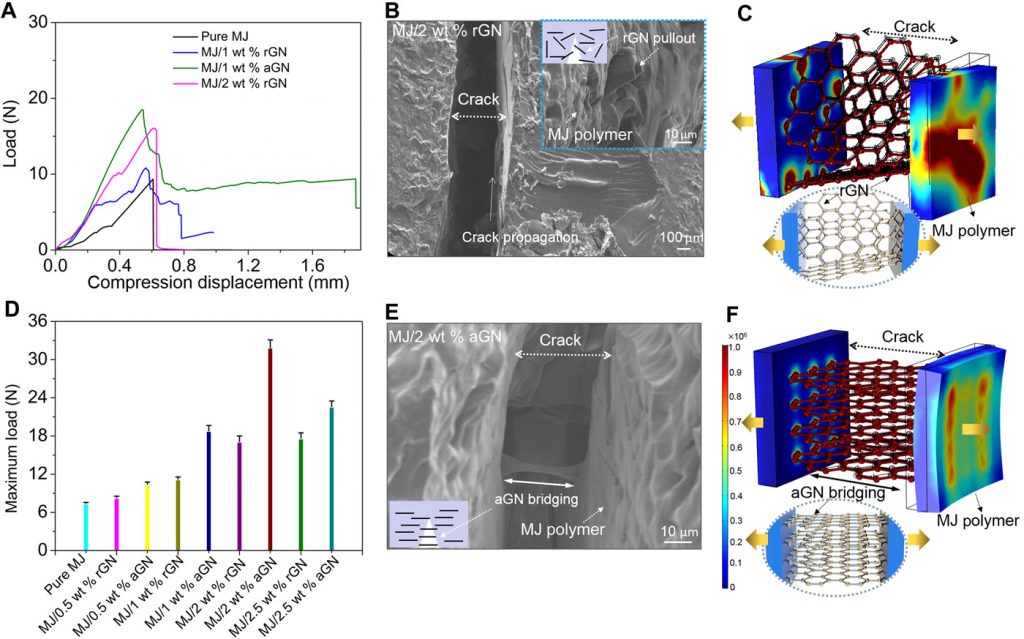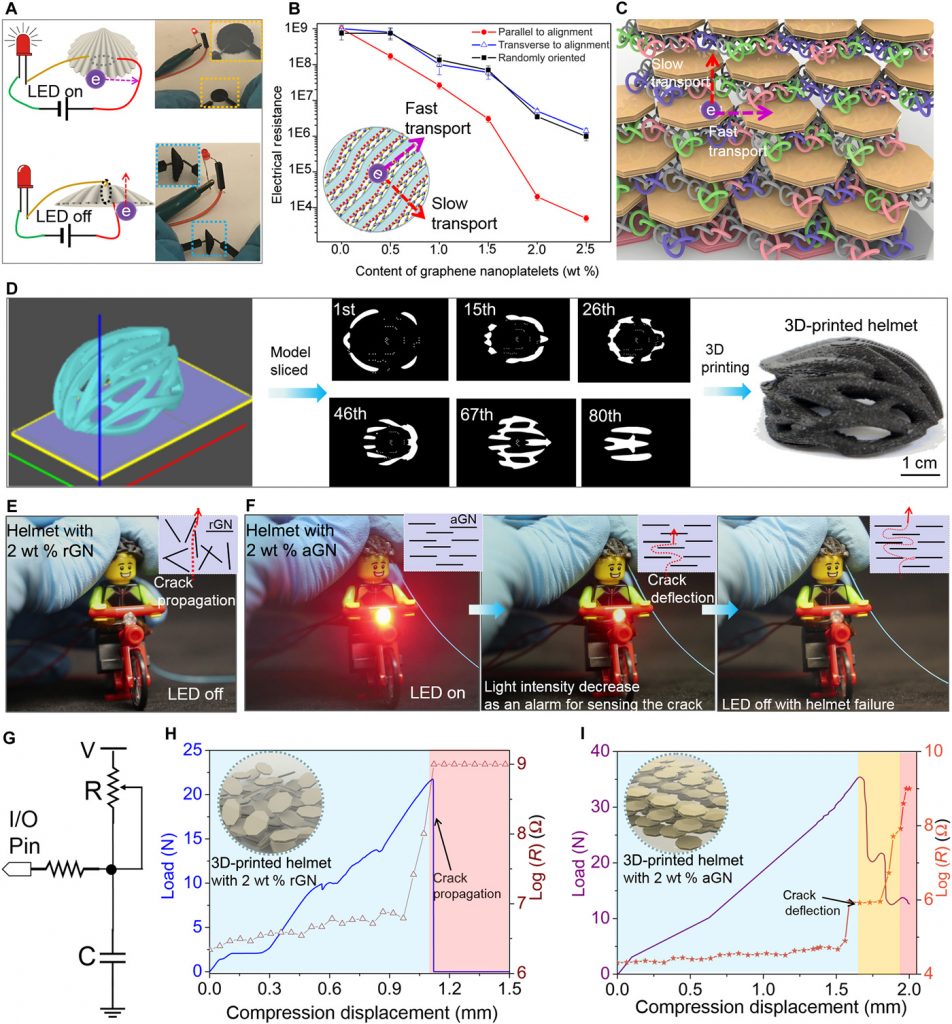 University of Southern California researchers delve into the inspiration of nature in ‘Electrically assisted 3D printing of nacre-inspired structures with self-sensing capability,’ inspired by the strength of shells in building ‘electrically assisted’ 3D parts, with the help of conductive materials. The structure of nacre is popular as a model today because it can unlock the secret to mechanical performance, and as the researchers point out, its composition is like a brick and mortar architecture. As is so often required for vital industrial 3D printed parts, the nacre structure allows for a lightweight yet strong structure.
University of Southern California researchers delve into the inspiration of nature in ‘Electrically assisted 3D printing of nacre-inspired structures with self-sensing capability,’ inspired by the strength of shells in building ‘electrically assisted’ 3D parts, with the help of conductive materials. The structure of nacre is popular as a model today because it can unlock the secret to mechanical performance, and as the researchers point out, its composition is like a brick and mortar architecture. As is so often required for vital industrial 3D printed parts, the nacre structure allows for a lightweight yet strong structure.
“Recently, different types of nacre-inspired layered nanocomposites have been fabricated with inorganic additives, including glass flake, alumina flake, graphene, and graphene nanoplatelets,” state the researchers. “Traditional bottom-up assembly processes, including vacuum filtration, spray coating, ice templating, and self-assembly, have been intensively studied to fabricate nacre-inspired structures.”
So far, however, these types of methods have been devoted to the 2D realm, in creating more simple shapes—and for one main reason: it is difficult to use such techniques for creating 3D objects that are ‘enhanced’ and mechanically strong. The researchers see 3D printing as the possible ticket to success in overcoming previous obstacles for fabrication of complex structures that are not only inspired by nature but can be imbued with powerful electrical and mechanical qualities.

Schematic diagram of the electrically assisted 3D-printing platform for the construction of nacre-inspired structures.
In their research, the team outlines their new procedure for 3D printing in photocurable resin with aligned graphene nanoplatelets, also known as aGNs. The structures they have been able to 3D print are promising; in fact, they are as strong as regular graphene nanoplatelets, and as tough as real nacre.
“A smart helmet with both protective property and self-sensing capability can be fabricated using the electrically assisted 3D Eprinting process,” state the authors. “The bioinspired brick and mortar architecture enhance the mechanical strength and electrical conduction by aligning GN in each layer to maximize their performance by crack deflection under loading. The electrically assisted 3D-printing method can build a multifunctional lightweight and strong 3D structure with electrically self-sensing capability.”
In a somewhat amazing discovery, the research team realized that just as true nacre can deflect cracks, so can the 3D printed version. They found that as energy dissipation is enhanced by the features allowing for such deflection, greater toughness is achieved in the structures. The fabricated version also displays enhanced conductivity which could prove beneficial for a variety of applications, but the researchers again mention how useful it would be in creating armor. The customization options are vast also, including wearables and other smart technology too.
“This study shows that the alignment of GN creates the bridge and interlock, which is essential to confer the stress-induced damage in the 3D-printed structure. The developed electrically assisted 3D-printing process can fabricate structures with excellent integrated mechanical and electrical properties as well as complex 3D shapes,” concluded the researchers. “Such a new fabrication technique could enable the design and fabrication of the smart structures that are lightweight yet strong for various potential applications in biomedical, aerospace, transportation, sports, and military industries.”
Being able to print lightweight yet strong parts is a major benefit of 3D printing, often allowing users and large companies to innovate like never—simply because they never had such materials and technology at their fingertips before. Applications such as automotive, aerospace, medical, sports, and more are all being impacted.
While the more technical term shell nacre is not one that everyone may be familiar with, mother-of-pearl usually is. And you may be surprised at how often it has been connected with 3D printing, from the study of mechanical load in mollusks to inspiration from conchs to the development of synthetic bone. Find out more about nacre-inspired structures with sensors here. What do you think of this news? Let us know your thoughts! Join the discussion of this and other 3D printing topics at 3DPrintBoard.com.
[Source / Images: Electrically assisted 3D printing of nacre-inspired structures with self-sensing capability]Subscribe to Our Email Newsletter
Stay up-to-date on all the latest news from the 3D printing industry and receive information and offers from third party vendors.
You May Also Like
3D Printing Webinar and Event Roundup: May 5, 2024
We’ve got a busy week of 3D printing events ahead of us, in Texas, Florida, Washington, D.C., Shanghai, and more. Webinar offerings will cover medical models, PolyJet 3D printing, additive...
High Stakes, High Speed: KVG Acquires 15 Nexa3D HSE 3D Printers to Boost Military Tech
As 3D printing increasingly intersects with defense and military logistics, a new partnership between Nexa3D and mission support logistics firm KVG stresses the growing importance of this technology in strategic...
Construction 3D Printing CEO Reflects on Being Female in Construction
Natalie Wadley, CEO of ChangeMaker3D, could hear the words of her daughter sitting next to her resounding in her head. “Mum, MUM, you’ve won!” Wadley had just won the prestigious...
3D Printing News Briefs, February 17, 2024: Shot Blasting, Service Bureaus, & More
In today’s 3D Printing News Briefs, we’re starting out with post-processing, as SKZ Würzburg is using a shot blast system from AM Solutions for its research. Moving on to business,...

































